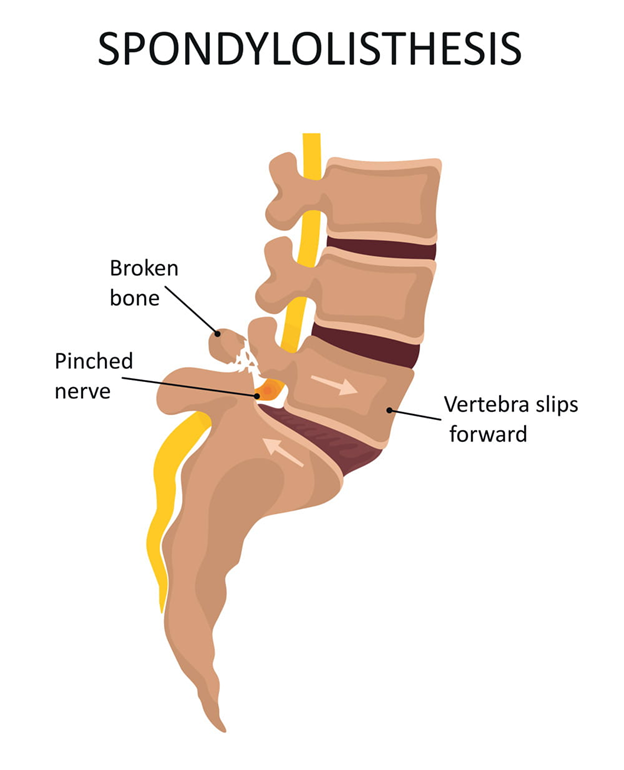Spondylolisthesis is a condition where one of your vertebrae slips out of its proper place onto the bone below it. It’s essential to catch this early for the best health outcomes. When identified promptly, effective treatments can bring relief and prevent complications. Understanding what causes it and how it presents itself is key to making sure you can deal with it effectively.

What is Spondylolisthesis?
Imagine your spine as a stack of blocks. In spondylolisthesis, one of these blocks, or vertebrae, has slipped forward over its neighbor. This can lead to discomfort and limit your movement ability. Many people may have this condition without even knowing it because it doesn’t always cause symptoms immediately. Spondylolisthesis tends to be more common among teenagers and older adults. Young athletes and older individuals experiencing wear and tear are often those most affected. Understanding this condition helps you take steps towards better spinal health.
Spotting the Symptoms: When Should You Be Concerned?
The symptoms of spondylolisthesis can vary significantly. While it might start with mild discomfort, it can escalate to severe pain. Typical signs include:
- Lower back pain, which can be persistent or come and go.
- Pain extending to your thighs and legs when moving or standing.
- Numbness or a tingling feeling, which could indicate nerve involvement.
For some, pain feels different. It might vary from a dull ache to sharp pain. Others may experience muscle weakness or stiffness, especially after sitting for a long time. Because these symptoms can mimic other conditions, it’s important to have a medical professional like Dr. Shekhar Reddy involved early on.
Root Causes & Risk Factors Behind Spondylolisthesis
Spondylolisthesis can occur in people of all ages but is usually seen in specific groups. For younger people, it might be congenital, meaning they were born with it, or due to sports that strain the spine. Activities like gymnastics or weightlifting increase the risk.
For adults, the causes often relate to aging where spinal discs degenerate over time. Common risk factors include:
- Participation in certain high-impact sports
- Being female, as women are more likely to develop this
- Age-related changes in the spine
Lifestyle choices and previous back injuries can also heighten the risk, meaning taking care of your spine is vital.
Exploring Types: Understanding Spondylolisthesis Classifications
There are several types of spondylolisthesis. Congenital spondylolisthesis means some people are born with it. Isthmic spondylolisthesis generally arises from a small fracture, often linked to stress from physical activity.
Understanding these types helps doctors decide the best course of action. The type influences what you can expect in terms of treatment and recovery. Diagnosing the specific kind of spondylolisthesis is crucial for forming an effective treatment plan.
Diagnosing Spondylolisthesis: Key Evaluations and Tests
Before deciding on a treatment path, diagnosing spondylolisthesis involves some evaluations. Physicians conduct physical exams to assess pain and function. They will likely ask you to move or walk to see how your spine behaves.
Imaging tests like X-rays or MRIs are foundational in confirming spondylolisthesis. These images help highlight the level and extent of the vertebra’s slippage. An accurate diagnosis is key because it shapes the treatment plan.
Dr. Shekhar Reddy is renowned for his expertise in this area. His thorough approach ensures that every aspect of your condition is understood, allowing for a tailored treatment strategy.
Navigating Treatment Options and Lifestyle Adjustments
Treatment for spondylolisthesis can vary from non-invasive to surgical interventions. Here’s a general overview:
- Rest and Activity Modification: Sometimes, simply resting and avoiding certain activities is enough.
- Pain Relief Medications: Over-the-counter drugs can help manage pain.
- Physical Therapy: Exercises strengthen back and abdominal muscles.
Surgical options might be considered if conservative methods are unsuccessful. One common procedure is spinal fusion, where bones are joined together.
Self-care tips include maintaining a healthy weight and ensuring good posture.
Prevention Strategies and Living Optimally with Spondylolisthesis
Preventing spondylolisthesis involves a few lifestyle changes:
- Exercise Regularly: Maintaining flexibility and strength can protect your spine.
- Lift Properly: Using your legs instead of your back reduces strain.
- Ergonomics: Arrange your workspace to avoid uncomfortable positions.
Remember, dealing with spondylolisthesis isn’t just physical. Addressing worries or fears about living with this condition is also crucial. Engaging with healthcare professionals regularly can help you mitigate risks and live a fuller life.
Conclusion: Key Takeaways and Encouragement
Understanding spondylolisthesis is the first step toward getting relief. Recognizing symptoms early and seeking diagnosis can significantly impact your outcome. Managing the condition involves not only physical care but also psychological well-being.
If you encounter persistent back discomfort, a timely consultation is vital. Dr. Shekhar Reddy’s expertise can guide you through personalized care and treatment plans. Don’t wait to prioritize your spine health—you deserve to live life to the fullest. Always explore professional options to ensure the best outcomes from your health journey.



